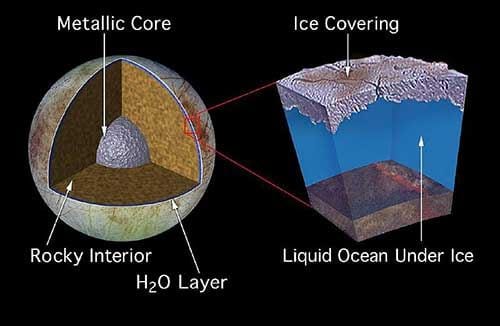Back in June 2016 I advertised a postdoctoral position between me and Steve Desch at ASU for someone to work on the problem of exoplanet interior compositions.
Normally, the way we determine the interior composition of exoplanets is a combination of inference, measurement, and guesswork. In the Solar System we can study the surface compositions of planets directly, get the bulk density by dividing masses by radii cubed, and a sense of internal structure by looking at how the surfaces have changed or what a body’s gravitational field says about the interior mass distribution. It’s amazing how much we can determine about, say, the interior of Europa!

Evidence from NASA’s Galileo mission suggested that there might be a liquid water ocean underneath Europa’s icy crust. Image credit: NASA/JPL
On Earth we can also use seismology to directly probe the density and composition of the Earth’s interior. Some things we still don’t know to great precision (the water content of Earth’s mantle is still pretty uncertain, though it’s small) but in general we have a good sense of what’s down there, despite having a very limited set of actual samples from far below the surface (from volcanos, mostly).
Based on this we have a good sense of how the planets formed, and so we can make good inferences and guesses about the parts we don’t know about yet. For instance, we suspect that Jupiter formed around a rocky core of about ten times the mass of the Earth; one of the purposes of Juno is to see if we can better determine Jupiter’s inner composition and perhaps check this model prediction.

This artist’s concept shows the pole-to-pole orbits of the NASA’s Juno spacecraft at Jupiter. Image credit: NASA/JPL-Caltech/SwRI
Exoplanets are much harder. We generally can measure their masses from radial velocities and radii if they transit, and for planets for which we have both we have bulk densities. By analogy with Solar System planets we can then guess that they have similar compositions to those, and from the compositions of their host stars we can make inferences about how they might differ. But getting anything like a mantle or surface sample seems impossible.
Except…
There is a whole class of planet recently discovered by Kepler (Saul Rappaport and Roberto Sanchis Ojeda did a lot of the pioneering work here) that appears to be evaporating. The transit signatures of these things is amazing; they vary in depth (sometimes disappearing entirely!) and don’t have the usual shape of transiting planets. Apparently, these are small rocky bodies (which have orbital periods of less than a day and which are too small to see transit at all) have gigantic, variable tails of rock that is condensing from a plume of surface material evaporated by the intense heat of their parent star.

 Studies of white dwarf “pollution” can measure the bulk, relative elemental abundances of material from presumably rocky planets that have crashed into the white dwarf, but here we have the opportunity to study chemical composition of one particular layer of a distant rocky exoplanet—we can’t even do this for the Earth!
Studies of white dwarf “pollution” can measure the bulk, relative elemental abundances of material from presumably rocky planets that have crashed into the white dwarf, but here we have the opportunity to study chemical composition of one particular layer of a distant rocky exoplanet—we can’t even do this for the Earth!
But will it work? Are the transits deep enough? Can we distinguish different minerals with spectroscopy? Are there any stars bright enough for this?

